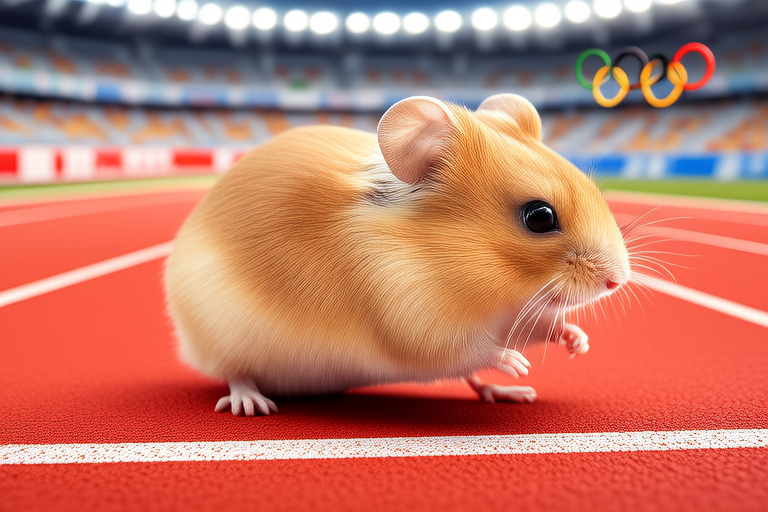Hamster Olympics: The Athletic Abilities of Your Golden Pet
Welcome to the Hamster Olympics, where we celebrate the incredible athletic prowess of our golden furry friends. Hamsters, despite their small size, possess remarkable physical attributes that make them exceptional athletes. In this article, we will explore the unique physical characteristics that enable hamsters to excel in various athletic activities. We’ll delve into the scientific insights behind these abilities, discuss suitable exercises for your pet, and share inspiring stories of hamster athleticism.
The Unique Physical Attributes of Hamsters
Hamsters are tiny creatures, but they are packed with surprising physical capabilities. Their bodies are designed for endurance and speed, which are crucial for survival in the wild. One of the most notable features is their powerful hind legs, which provide propulsion for quick bursts of speed and agile movements. These legs also contribute to their impressive running speeds, which can reach up to six miles per hour. Their compact bodies and strong muscles enable them to move efficiently, even in tight spaces.
Another distinctive attribute is their sharp claws, which aid in climbing and digging. Hamsters have excellent balance and coordination, making them adept at navigating narrow passages and climbing vertical surfaces. Their flexible spines allow them to twist and turn in tight spots, further enhancing their agility. Additionally, hamsters have highly sensitive whiskers and ears, which help them detect potential threats and navigate their environment effectively.
Athletic Activities Hamsters Can Perform
Hamsters are versatile athletes capable of performing a variety of physical activities. Running is one of their favorite pastimes and an essential exercise for maintaining their health. They can run several miles each night on a hamster wheel, showcasing their stamina and endurance. Agility courses are another excellent way to challenge your hamster’s abilities. Set up small obstacles such as tunnels, bridges, and ramps for your pet to navigate, encouraging them to use their natural instincts and problem-solving skills.
Strength is another aspect of hamsters’ athletic abilities. While they may not be able to lift heavy weights like some larger animals, hamsters can carry objects that are surprisingly large relative to their size. This ability comes in handy when they need to transport food or bedding materials to their nests. Additionally, hamsters are skilled climbers, capable of scaling smooth surfaces and reaching high places with ease.
Scientific Insights on Hamster Athleticism
In the wild, hamsters’ athletic abilities play a crucial role in their survival. Their speed allows them to escape predators and find safe hiding spots. Agility helps them navigate complex environments, avoiding obstacles and finding food sources. Strength is vital for digging burrows and transporting resources. In domestic settings, these abilities translate into enjoyable and enriching activities for pet owners and their furry companions.
Research has shown that regular exercise is essential for maintaining hamsters’ physical and mental well-being. Exercise helps prevent obesity, strengthens muscles and bones, and reduces stress levels. It also stimulates cognitive function, improving problem-solving skills and memory retention. Providing opportunities for physical activity can enhance your hamster’s quality of life and strengthen the bond between you and your pet.
Tips for Encouraging and Safely Engaging Hamsters in Physical Activities
To ensure your hamster stays healthy and active, it’s important to create a stimulating environment that encourages physical activity. Start by providing a spacious cage with plenty of room to run and explore. Include toys and accessories that promote movement, such as tunnels, bridges, and exercise wheels. Rotate these items periodically to keep your hamster engaged and prevent boredom.
Supervise your hamster during exercise sessions to ensure their safety. Always monitor their activity level and watch for signs of fatigue or distress. If your hamster appears tired or uncomfortable, give them time to rest before resuming playtime. Additionally, ensure that all exercise equipment is safe and free from sharp edges or small parts that could pose a choking hazard.
Anecdotes and Stories of Hamster Athletic Feats
One story that exemplifies hamster athleticism involves a pet hamster named Speedy, who amazed his owner with his running abilities. Speedy’s owner had installed a hamster wheel in his cage, and over time, Speedy’s running speed increased significantly. One evening, while watching Speedy run, the owner noticed that the hamster was maintaining a steady pace for an extended period. Intrigued, the owner decided to time Speedy’s run and discovered that he had covered more than two miles in a single night! This remarkable achievement showcased Speedy’s endurance and determination.
Another tale of hamster athleticism comes from a rescue shelter, where a hamster named Whiskers displayed exceptional climbing skills. Whiskers had been living in a cage with limited vertical space, so when the shelter staff introduced a new climbing structure, Whiskers eagerly explored every inch of it. Within minutes, Whiskers had scaled the tallest part of the structure and was exploring the upper reaches of his new home. His agility and balance impressed everyone who witnessed his performance, and Whiskers quickly became a favorite among the shelter staff and visitors alike.
These stories highlight the incredible athletic abilities of hamsters and serve as inspiration for pet owners to encourage their pets to engage in physical activities. By providing a stimulating environment and regular exercise opportunities, you can help your hamster maintain optimal health and enjoy a fulfilling life.
